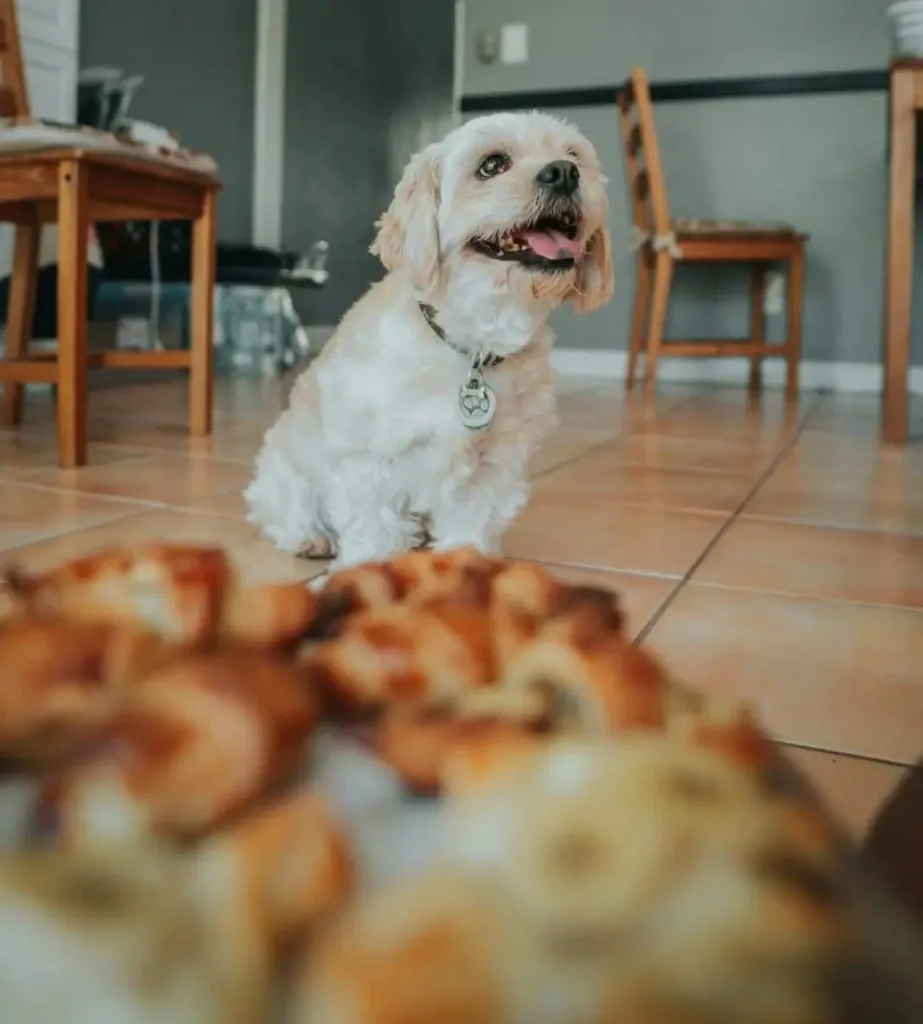Pet owners often ask, “Can dogs eat garlic bread?” when their furry friends beg for a bite of this savory treat. Garlic bread, with its buttery, garlicky flavor, is a human favorite, but is it safe for dogs? The short answer is no—garlic is toxic to dogs, and garlic bread poses serious health risks. In this comprehensive guide, we’ll explore why garlic bread is dangerous, symptoms of garlic poisoning, safe alternatives, and what to do if your dog eats it. Packed with expert insights, this article answers all your questions about garlic toxicity in dogs to keep your pet safe and healthy.
What is Garlic Bread?
Garlic bread is a delicious side dish made by spreading a mixture of butter, garlic (fresh cloves or powder), herbs like parsley, and sometimes cheese on bread, then baking or toasting it until crispy. While it’s a crowd-pleaser for humans, garlic bread contains ingredients harmful to dogs, including high-fat butter, salt, and the primary concern—garlic, a member of the toxic Allium family. Understanding what’s in garlic bread is key to answering, “Is garlic bread bad for dogs?” The garlic itself, whether raw, cooked, or powdered, is the main culprit behind its dangers.
Can Dogs Eat Garlic Bread?

No, dogs should not eat garlic bread. Garlic, in any form—fresh, cooked, or powdered—is toxic to dogs and can cause serious health issues, including hemolytic anemia. Additionally, the high fat content from butter or oil in garlic bread can lead to gastrointestinal upset, such as vomiting or diarrhea, and in severe cases, pancreatitis. A tiny crumb might not cause immediate harm, but even small amounts of garlic can accumulate and pose risks over time. To keep your dog safe, avoid sharing garlic bread and opt for dog-friendly treats instead.
Why is Garlic Bad for Dogs?
Garlic is harmful to dogs because it contains thiosulfates and N-propyl disulfides, compounds that damage red blood cells, leading to hemolytic anemia. Unlike humans, dogs lack the enzymes to safely process these substances, making garlic about five times more toxic than onions. Whether raw, cooked, or in powder form, garlic remains dangerous, debunking myths like “Is cooked garlic safe for dogs?” Small breeds and dogs with health issues are particularly vulnerable, and repeated exposure can worsen the risks of garlic toxicity in dogs.
How Much Garlic Bread Can a Dog Eat?
No amount of garlic bread is considered safe for dogs, but the toxic dose of garlic varies by size. A dose of 15–30 grams of garlic per kilogram of body weight can cause toxicity—equivalent to a few cloves for small dogs. For instance, a 10-pound dog could face serious risks from just one slice of garlic bread, especially if it contains concentrated garlic powder. Even 2 grams per pound can cause stomach upset, so it’s best to avoid garlic bread entirely to prevent garlic poisoning in dogs.
Symptoms of Garlic Toxicity in Dogs
Recognizing the symptoms of garlic toxicity in dogs is critical for early intervention, as garlic’s toxic compounds, like thiosulfates, can harm red blood cells and lead to hemolytic anemia. Symptoms may appear within hours or up to 5 days after your dog eats garlic bread, making vigilance key. Below, we outline the warning signs to watch for to protect your pet from garlic poisoning.
Digestive Distress
The first symptoms often affect the digestive system, as garlic irritates the stomach and intestines. Look for vomiting, diarrhea, abdominal discomfort, or excessive drooling. Your dog may also refuse food or show signs of nausea. These early signs of garlic poisoning in dogs typically appear within 24 hours and signal the need to monitor closely or contact a vet.
Anemia Warning Signs
Garlic’s damage to red blood cells can lead to hemolytic anemia, a serious condition. Watch for pale or yellowish (jaundiced) gums, dark or reddish urine, rapid breathing, or a fast heartbeat. Weakness and lethargy are also common as oxygen transport falters. These symptoms of garlic toxicity in dogs are urgent and require immediate veterinary care to prevent severe complications.
Behavioral and Systemic Changes
Beyond physical symptoms, garlic poisoning can cause behavioral changes like lethargy, depression, or difficulty walking (ataxia). In severe cases, dogs may collapse or show a garlic-like odor on their breath. Smaller breeds are more susceptible, and symptoms may worsen over time. If you notice these changes after garlic bread consumption, act quickly to address potential garlic toxicity.
When to Act
Even mild symptoms warrant attention, as garlic poisoning can escalate. Contact your veterinarian or a pet poison hotline if you suspect your dog ingested garlic. Quick action can prevent long-term harm from garlic toxicity in dogs, ensuring your pet’s safety.
If Garlic is Poisonous to Dogs, Why Do Some Experts Still Recommend It?

Some holistic veterinarians and pet owners advocate for tiny doses of garlic as a natural remedy for fleas, ticks, or immune support, claiming it detoxifies the gut or repels parasites. However, mainstream veterinary sources strongly advise against it, citing a lack of scientific evidence for benefits and significant risks of toxicity. Trace amounts in some AAFCO-approved dog foods are deemed safe, but direct feeding of garlic or garlic bread is risky. Always consult your vet before considering garlic for dogs to avoid garlic poisoning.
Treatment for Garlic Toxicity
Treating garlic toxicity in dogs focuses on removing the toxin, managing symptoms, and supporting recovery, as there is no specific antidote. Prompt veterinary care is essential, especially within hours of ingestion. Here’s how vets typically handle garlic poisoning in dogs to ensure a safe recovery.
Immediate Response
If your dog eats garlic bread, act fast by contacting a vet or pet poison hotline within 2 hours. They may recommend inducing vomiting to expel the garlic, but only under professional guidance to avoid complications. Secure any remaining garlic bread and offer fresh water to keep your dog hydrated while awaiting advice.
Veterinary Care
At the clinic, vets may use activated charcoal to bind toxins in the stomach, preventing further absorption. For severe cases, blood tests can confirm anemia, potentially requiring blood transfusions or oxygen therapy. These interventions address the root of garlic toxicity in dogs, stabilizing your pet’s condition.
Supportive Treatment
Supportive care includes IV fluids to prevent dehydration and medications to manage vomiting, diarrhea, or pain. Hospitalization may be needed for close monitoring, especially if symptoms like rapid heart rate persist. A bland diet post-treatment helps ease digestive recovery, ensuring comprehensive care for garlic poisoning in dogs.
Recovery Outlook
With timely treatment, most dogs recover fully within days, though severe cases may require weeks for red blood cell regeneration. Follow-up vet visits ensure no lasting damage, like kidney issues. To prevent future incidents, avoid garlic and other Allium foods, keeping your dog safe from garlic toxicity risks.
What to Do If Your Dog Eats Garlic Bread
If your dog sneaks a bite of garlic bread, stay calm but act quickly. Estimate how much was eaten—a small piece may cause mild upset, while larger amounts are more dangerous. Call your vet or a pet poison hotline for guidance. Monitor for symptoms like vomiting or lethargy, and avoid inducing vomiting at home unless instructed by a professional. Keep your dog comfortable, provide water, and follow veterinary advice to mitigate garlic poisoning risks.
Before Sharing With Your Pooch
Before offering any human food, check for toxic ingredients like garlic, onions, or other Alliums. Consider your dog’s size, breed, and health—smaller dogs face higher risks from even tiny amounts of garlic. Instead of garlic bread, choose dog-safe treats to avoid health issues like obesity or garlic toxicity. When in doubt about “Can dogs eat this?”, consult your vet to ensure your pet’s safety.
Alternatives to Garlic Bread for Dogs
Instead of risky garlic bread, offer dog-friendly treats that are safe and nutritious. Plain, unsalted bread in moderation is okay, but better options include crunchy carrot sticks, seedless apple slices, or cucumber chunks. Xylitol-free peanut butter in a toy, commercial dog biscuits, or homemade treats with pumpkin and oats are great choices. These alternatives satisfy your dog’s craving without the dangers of garlic toxicity.
FAQ
Is garlic bread toxic to dogs?
Yes, garlic in any form can cause hemolytic anemia and digestive issues.
What if my dog ate garlic bread accidentally?
Monitor for symptoms and contact your vet immediately.
Is powdered garlic safe for dogs?
No, it’s highly concentrated and toxic.
Can garlic prevent fleas in dogs?
There’s no solid evidence, and safer flea treatments are available.
Final Takeaways
To wrap up, can dogs eat garlic bread? Absolutely not—garlic’s toxic compounds pose serious risks, including hemolytic anemia and digestive upset. Keep garlic bread and other Allium foods out of reach, and opt for safe alternatives like carrot sticks or dog biscuits. If your dog consumes garlic bread, act fast by contacting a vet to address potential garlic poisoning. By staying informed about garlic toxicity in dogs, you can protect your furry friend from harm and ensure a long, healthy life.

